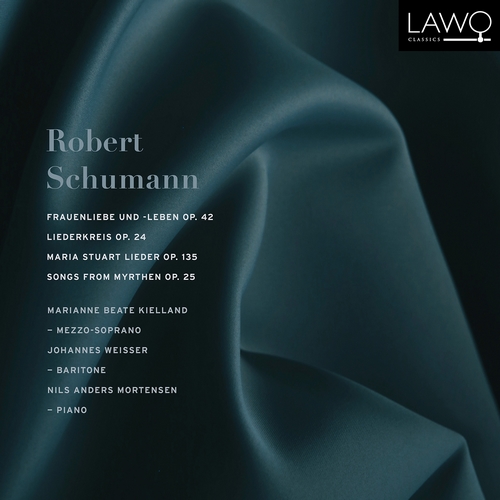
Wydawnictwo: Lawo Classics
Nr katalogowy: LWC 1197
Nośnik: 1 CD
Data wydania: czerwiec 2020
EAN: 7090020182193
Nr katalogowy: LWC 1197
Nośnik: 1 CD
Data wydania: czerwiec 2020
EAN: 7090020182193
Schumann: Frauenliebe, Liederkreis, Maria Stuart, Songs from Myrthe
Lawo Classics - LWC 1197
Kompozytor
Robert Schumann (1810-1856)
Robert Schumann (1810-1856)
Wykonawcy
Marianne Beate Kielland, mezzo-soprano
Johannes Weisser, baritone
Nils Anders Mortensen, piano
Marianne Beate Kielland, mezzo-soprano
Johannes Weisser, baritone
Nils Anders Mortensen, piano
Utwory na płycie:
 Liederkreis, Op. 24 - I. Morgens steh' ich auf
Liederkreis, Op. 24 - I. Morgens steh' ich auf Liederkreis, Op. 24 - II. Es treibt mich hin
Liederkreis, Op. 24 - II. Es treibt mich hin Liederkreis, Op. 24 - III. Ich wandelte unter den Bäumen
Liederkreis, Op. 24 - III. Ich wandelte unter den Bäumen Liederkreis, Op. 24 - IV. Lieb' Liebchen
Liederkreis, Op. 24 - IV. Lieb' Liebchen Liederkreis, Op. 24 - V. Schöne Wiege meiner Leiden
Liederkreis, Op. 24 - V. Schöne Wiege meiner Leiden Liederkreis, Op. 24 - VI. Warte, warte, wilder Schiffmann
Liederkreis, Op. 24 - VI. Warte, warte, wilder Schiffmann Liederkreis, Op. 24 - VII. Berg' und Burgen schau'n herunter
Liederkreis, Op. 24 - VII. Berg' und Burgen schau'n herunter Liederkreis, Op. 24 - VIII. Anfangs wollt' ich fast verzagen
Liederkreis, Op. 24 - VIII. Anfangs wollt' ich fast verzagen Liederkreis, Op. 24 - IX. Mit Myrthen und Rosen
Liederkreis, Op. 24 - IX. Mit Myrthen und Rosen Myrthen, Op. 25 - III. Der Nussbaum
Myrthen, Op. 25 - III. Der Nussbaum Myrthen, Op. 25 - I. Widmung
Myrthen, Op. 25 - I. Widmung Gedichte der Königin Maria Stuart, Op. 135 - I. Abschied von Frankreich
Gedichte der Königin Maria Stuart, Op. 135 - I. Abschied von Frankreich Gedichte der Königin Maria Stuart, Op. 135 - II. Nach der Geburt ihres Sohnes
Gedichte der Königin Maria Stuart, Op. 135 - II. Nach der Geburt ihres Sohnes Gedichte der Königin Maria Stuart, Op. 135 - III. An die Königin Elisabeth
Gedichte der Königin Maria Stuart, Op. 135 - III. An die Königin Elisabeth Gedichte der Königin Maria Stuart, Op. 135 - IV. Abschied von der Welt
Gedichte der Königin Maria Stuart, Op. 135 - IV. Abschied von der Welt Gedichte der Königin Maria Stuart, Op. 135 - V. Gebet
Gedichte der Königin Maria Stuart, Op. 135 - V. Gebet Myrthen, Op. 25 - XXIV. Du bist wie eine Blume
Myrthen, Op. 25 - XXIV. Du bist wie eine Blume Frauenliebe und -leben, Op. 42 - I. Seit ich ihn gesehen
Frauenliebe und -leben, Op. 42 - I. Seit ich ihn gesehen Frauenliebe und -leben, Op. 42 - II. Er, der Herrlichste von allen
Frauenliebe und -leben, Op. 42 - II. Er, der Herrlichste von allen Frauenliebe und -leben, Op. 42 - III. Ich kann's nicht fassen
Frauenliebe und -leben, Op. 42 - III. Ich kann's nicht fassen Frauenliebe und -leben, Op. 42 - IV. Du Ring an meinem Finger
Frauenliebe und -leben, Op. 42 - IV. Du Ring an meinem Finger Frauenliebe und -leben, Op. 42 - V. Helft mir, ihr Schwestern
Frauenliebe und -leben, Op. 42 - V. Helft mir, ihr Schwestern Frauenliebe und -leben, Op. 42 - VI. Süsser Freund, du blickest
Frauenliebe und -leben, Op. 42 - VI. Süsser Freund, du blickest Frauenliebe und -leben, Op. 42 - VII. An meinem Herzen
Frauenliebe und -leben, Op. 42 - VII. An meinem Herzen Frauenliebe und -leben, Op. 42 - VIII. Nun hast du mir den ersten Schmerz getan
Frauenliebe und -leben, Op. 42 - VIII. Nun hast du mir den ersten Schmerz getan
00:00/00:00















